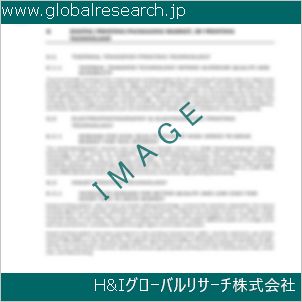1 Poly(n-butyl vinyl ether) Market Overview
1.1 Product Definition
1.2 Poly(n-butyl vinyl ether) Segment by Type
1.2.1 Global Poly(n-butyl vinyl ether) Market Value Growth Rate Analysis by Type 2022 VS 2029
1.2.2 98% Purity
1.2.3 99% Purity
1.3 Poly(n-butyl vinyl ether) Segment by Application
1.3.1 Global Poly(n-butyl vinyl ether) Market Value Growth Rate Analysis by Application: 2022 VS 2029
1.3.2 Coating
1.3.3 Plasticizer
1.3.4 Adhesive
1.3.5 Organic Intermediate
1.3.6 Other
1.4 Global Market Growth Prospects
1.4.1 Global Poly(n-butyl vinyl ether) Production Value Estimates and Forecasts (2018-2029)
1.4.2 Global Poly(n-butyl vinyl ether) Production Capacity Estimates and Forecasts (2018-2029)
1.4.3 Global Poly(n-butyl vinyl ether) Production Estimates and Forecasts (2018-2029)
1.4.4 Global Poly(n-butyl vinyl ether) Market Average Price Estimates and Forecasts (2018-2029)
1.5 Assumptions and Limitations
2 Market Competition by Manufacturers
2.1 Global Poly(n-butyl vinyl ether) Production Market Share by Manufacturers (2018-2023)
2.2 Global Poly(n-butyl vinyl ether) Production Value Market Share by Manufacturers (2018-2023)
2.3 Global Key Players of Poly(n-butyl vinyl ether), Industry Ranking, 2021 VS 2022 VS 2023
2.4 Global Poly(n-butyl vinyl ether) Market Share by Company Type (Tier 1, Tier 2 and Tier 3)
2.5 Global Poly(n-butyl vinyl ether) Average Price by Manufacturers (2018-2023)
2.6 Global Key Manufacturers of Poly(n-butyl vinyl ether), Manufacturing Base Distribution and Headquarters
2.7 Global Key Manufacturers of Poly(n-butyl vinyl ether), Product Offered and Application
2.8 Global Key Manufacturers of Poly(n-butyl vinyl ether), Date of Enter into This Industry
2.9 Poly(n-butyl vinyl ether) Market Competitive Situation and Trends
2.9.1 Poly(n-butyl vinyl ether) Market Concentration Rate
2.9.2 Global 5 and 10 Largest Poly(n-butyl vinyl ether) Players Market Share by Revenue
2.10 Mergers & Acquisitions, Expansion
3 Poly(n-butyl vinyl ether) Production by Region
3.1 Global Poly(n-butyl vinyl ether) Production Value Estimates and Forecasts by Region: 2018 VS 2022 VS 2029
3.2 Global Poly(n-butyl vinyl ether) Production Value by Region (2018-2029)
3.2.1 Global Poly(n-butyl vinyl ether) Production Value Market Share by Region (2018-2023)
3.2.2 Global Forecasted Production Value of Poly(n-butyl vinyl ether) by Region (2024-2029)
3.3 Global Poly(n-butyl vinyl ether) Production Estimates and Forecasts by Region: 2018 VS 2022 VS 2029
3.4 Global Poly(n-butyl vinyl ether) Production by Region (2018-2029)
3.4.1 Global Poly(n-butyl vinyl ether) Production Market Share by Region (2018-2023)
3.4.2 Global Forecasted Production of Poly(n-butyl vinyl ether) by Region (2024-2029)
3.5 Global Poly(n-butyl vinyl ether) Market Price Analysis by Region (2018-2023)
3.6 Global Poly(n-butyl vinyl ether) Production and Value, Year-over-Year Growth
3.6.1 North America Poly(n-butyl vinyl ether) Production Value Estimates and Forecasts (2018-2029)
3.6.2 Europe Poly(n-butyl vinyl ether) Production Value Estimates and Forecasts (2018-2029)
3.6.3 China Poly(n-butyl vinyl ether) Production Value Estimates and Forecasts (2018-2029)
3.6.4 Japan Poly(n-butyl vinyl ether) Production Value Estimates and Forecasts (2018-2029)
4 Poly(n-butyl vinyl ether) Consumption by Region
4.1 Global Poly(n-butyl vinyl ether) Consumption Estimates and Forecasts by Region: 2018 VS 2022 VS 2029
4.2 Global Poly(n-butyl vinyl ether) Consumption by Region (2018-2029)
4.2.1 Global Poly(n-butyl vinyl ether) Consumption by Region (2018-2023)
4.2.2 Global Poly(n-butyl vinyl ether) Forecasted Consumption by Region (2024-2029)
4.3 North America
4.3.1 North America Poly(n-butyl vinyl ether) Consumption Growth Rate by Country: 2018 VS 2022 VS 2029
4.3.2 North America Poly(n-butyl vinyl ether) Consumption by Country (2018-2029)
4.3.3 United States
4.3.4 Canada
4.4 Europe
4.4.1 Europe Poly(n-butyl vinyl ether) Consumption Growth Rate by Country: 2018 VS 2022 VS 2029
4.4.2 Europe Poly(n-butyl vinyl ether) Consumption by Country (2018-2029)
4.4.3 Germany
4.4.4 France
4.4.5 U.K.
4.4.6 Italy
4.4.7 Russia
4.5 Asia Pacific
4.5.1 Asia Pacific Poly(n-butyl vinyl ether) Consumption Growth Rate by Region: 2018 VS 2022 VS 2029
4.5.2 Asia Pacific Poly(n-butyl vinyl ether) Consumption by Region (2018-2029)
4.5.3 China
4.5.4 Japan
4.5.5 South Korea
4.5.6 China Taiwan
4.5.7 Southeast Asia
4.5.8 India
4.6 Latin America, Middle East & Africa
4.6.1 Latin America, Middle East & Africa Poly(n-butyl vinyl ether) Consumption Growth Rate by Country: 2018 VS 2022 VS 2029
4.6.2 Latin America, Middle East & Africa Poly(n-butyl vinyl ether) Consumption by Country (2018-2029)
4.6.3 Mexico
4.6.4 Brazil
4.6.5 Turkey
5 Segment by Type
5.1 Global Poly(n-butyl vinyl ether) Production by Type (2018-2029)
5.1.1 Global Poly(n-butyl vinyl ether) Production by Type (2018-2023)
5.1.2 Global Poly(n-butyl vinyl ether) Production by Type (2024-2029)
5.1.3 Global Poly(n-butyl vinyl ether) Production Market Share by Type (2018-2029)
5.2 Global Poly(n-butyl vinyl ether) Production Value by Type (2018-2029)
5.2.1 Global Poly(n-butyl vinyl ether) Production Value by Type (2018-2023)
5.2.2 Global Poly(n-butyl vinyl ether) Production Value by Type (2024-2029)
5.2.3 Global Poly(n-butyl vinyl ether) Production Value Market Share by Type (2018-2029)
5.3 Global Poly(n-butyl vinyl ether) Price by Type (2018-2029)
6 Segment by Application
6.1 Global Poly(n-butyl vinyl ether) Production by Application (2018-2029)
6.1.1 Global Poly(n-butyl vinyl ether) Production by Application (2018-2023)
6.1.2 Global Poly(n-butyl vinyl ether) Production by Application (2024-2029)
6.1.3 Global Poly(n-butyl vinyl ether) Production Market Share by Application (2018-2029)
6.2 Global Poly(n-butyl vinyl ether) Production Value by Application (2018-2029)
6.2.1 Global Poly(n-butyl vinyl ether) Production Value by Application (2018-2023)
6.2.2 Global Poly(n-butyl vinyl ether) Production Value by Application (2024-2029)
6.2.3 Global Poly(n-butyl vinyl ether) Production Value Market Share by Application (2018-2029)
6.3 Global Poly(n-butyl vinyl ether) Price by Application (2018-2029)
7 Key Companies Profiled
7.1 Jingzhou Xinjing Chemical
7.1.1 Jingzhou Xinjing Chemical Poly(n-butyl vinyl ether) Corporation Information
7.1.2 Jingzhou Xinjing Chemical Poly(n-butyl vinyl ether) Product Portfolio
7.1.3 Jingzhou Xinjing Chemical Poly(n-butyl vinyl ether) Production, Value, Price and Gross Margin (2018-2023)
7.1.4 Jingzhou Xinjing Chemical Main Business and Markets Served
7.1.5 Jingzhou Xinjing Chemical Recent Developments/Updates
7.2 Hubei Shengling Technology
7.2.1 Hubei Shengling Technology Poly(n-butyl vinyl ether) Corporation Information
7.2.2 Hubei Shengling Technology Poly(n-butyl vinyl ether) Product Portfolio
7.2.3 Hubei Shengling Technology Poly(n-butyl vinyl ether) Production, Value, Price and Gross Margin (2018-2023)
7.2.4 Hubei Shengling Technology Main Business and Markets Served
7.2.5 Hubei Shengling Technology Recent Developments/Updates
7.3 Shanghai Jinhong Chemical
7.3.1 Shanghai Jinhong Chemical Poly(n-butyl vinyl ether) Corporation Information
7.3.2 Shanghai Jinhong Chemical Poly(n-butyl vinyl ether) Product Portfolio
7.3.3 Shanghai Jinhong Chemical Poly(n-butyl vinyl ether) Production, Value, Price and Gross Margin (2018-2023)
7.3.4 Shanghai Jinhong Chemical Main Business and Markets Served
7.3.5 Shanghai Jinhong Chemical Recent Developments/Updates
8 Industry Chain and Sales Channels Analysis
8.1 Poly(n-butyl vinyl ether) Industry Chain Analysis
8.2 Poly(n-butyl vinyl ether) Key Raw Materials
8.2.1 Key Raw Materials
8.2.2 Raw Materials Key Suppliers
8.3 Poly(n-butyl vinyl ether) Production Mode & Process
8.4 Poly(n-butyl vinyl ether) Sales and Marketing
8.4.1 Poly(n-butyl vinyl ether) Sales Channels
8.4.2 Poly(n-butyl vinyl ether) Distributors
8.5 Poly(n-butyl vinyl ether) Customers
9 Poly(n-butyl vinyl ether) Market Dynamics
9.1 Poly(n-butyl vinyl ether) Industry Trends
9.2 Poly(n-butyl vinyl ether) Market Drivers
9.3 Poly(n-butyl vinyl ether) Market Challenges
9.4 Poly(n-butyl vinyl ether) Market Restraints
10 Research Finding and Conclusion
11 Methodology and Data Source
11.1 Methodology/Research Approach
11.1.1 Research Programs/Design
11.1.2 Market Size Estimation
11.1.3 Market Breakdown and Data Triangulation
11.2 Data Source
11.2.1 Secondary Sources
11.2.2 Primary Sources
11.3 Author List
11.4 Disclaimer
| ※参考情報 ポリ(n-ブチルビニルエーテル)は、構造的に特異な特性を持つ高分子化合物であり、その用途は広範囲にわたります。このポリマーは、n-ブチルビニルエーテルという単位が繰り返し結合して形成される鎖状の高分子です。ポリ(n-ブチルビニルエーテル)の特性、種類、用途、そして関連技術について詳細に述べます。 まず、ポリ(n-ブチルビニルエーテル)の基本的な定義としては、エーテル基を含むビニルエーテルのポリマーであり、n-ブチル基が結合していることから、特別な物理的および化学的特性を示します。ポリマー化の過程で、n-ブチルビニルエーテルが重合してこれらの高分子を形成し、さまざまな産業での利用が可能になります。このポリマーの特性は、主にその分子構造、分子量、そして重合度によって変化します。 ポリ(n-ブチルビニルエーテル)の特徴として、まずその柔軟性が挙げられます。n-ブチル基の存在により、ポリマーは柔軟であり、低温でも脆くなりにくい性質があります。また、このポリマーは耐薬品性に優れており、一般的な溶剤や酸、アルカリに対する安定性が高いことが特徴です。さらに、ポリ(n-ブチルビニルエーテル)は水分を吸収しにくく、そのため湿度の影響を受けにくい性質も持ちます。このため、特に医療や食品分野など、厳しい衛生基準が求められる環境での利用がされています。 ポリ(n-ブチルビニルエーテル)にはいくつかの種類があります。一般的には、重合度の異なる製品が用意されており、それによって特性が異なるため、用途に応じて選択されることが多いです。例えば、低重合度のポリマーは流動性が良く、溶接や接着剤としての用途が考えられます。一方で、高重合度のものは機械的強度が高く、耐熱性のある材料として利用されることが一般的です。 このポリマーは、さまざまな用途に利用されています。まず、接着剤としての使用が広く、一部の工業用製品や家庭用製品においても非常に効果的です。ポリ(n-ブチルビニルエーテル)の柔軟性と耐薬品性は、強力な接着性を生み出すため、プラスチックや金属、木材などの異なる材料の接合に適しています。また、このポリマーはコーティング材としても使用されることがあり、特に防水コーティングや防腐剤としての特性を活かして製品の寿命を延ばす役割を果たします。 さらには、ポリ(n-ブチルビニルエーテル)は医療分野でも注目されています。生体適合性があり、薬剤の緩慢放出システムや、医療用機器のコーティング材として利用されることが多いです。また、薬物送達システムとしても研究されており、特定の条件下で薬剤を段階的に放出する能力があるため、新たな治療法の開発に寄与することが期待されています。 ポリ(n-ブチルビニルエーテル)に関連する技術も進展しています。近年、多様な高分子材料との複合化によって、より高性能な新材料の開発が進んでいます。例えば、ナノ材料と組み合わせることによって、機械的特性や熱的特性をさらに向上させる試みが行われています。また、3Dプリンティング技術との関連でも、ポリ(n-ブチルビニルエーテル)が新たな材料として注目されていることが挙げられます。この技術の進展により、複雑な形状の部品や製品を製造する際に、ポリ(n-ブチルビニルエーテル)が持つ自由な流動性が大きな利点となるのです。 さらに、ポリ(n-ブチルビニルエーテル)は、環境に配慮した材料としても評価されています。生分解性のポリマーや、リサイクル可能な材料としての研究が進んでおり、持続可能な社会を目指す取り組みの一環として注目を集めています。これにより、将来的にはよりエコフレンドリーな製品開発が可能になるでしょう。 総じて、ポリ(n-ブチルビニルエーテル)は、その独特の特性により、多様な用途と応用が期待される高分子材料です。接着剤から医療分野まで、さまざまな産業での利用が進んでおり、今後もさらなる研究と技術革新によって、その可能性が広がることが期待されます。産業界及び学術界の両方において、ポリ(n-ブチルビニルエーテルの研究と応用が進展することで、より高度な技術革新や新製品の開発が実現されることでしょう。 |
❖ 免責事項 ❖
http://www.globalresearch.jp/disclaimer












